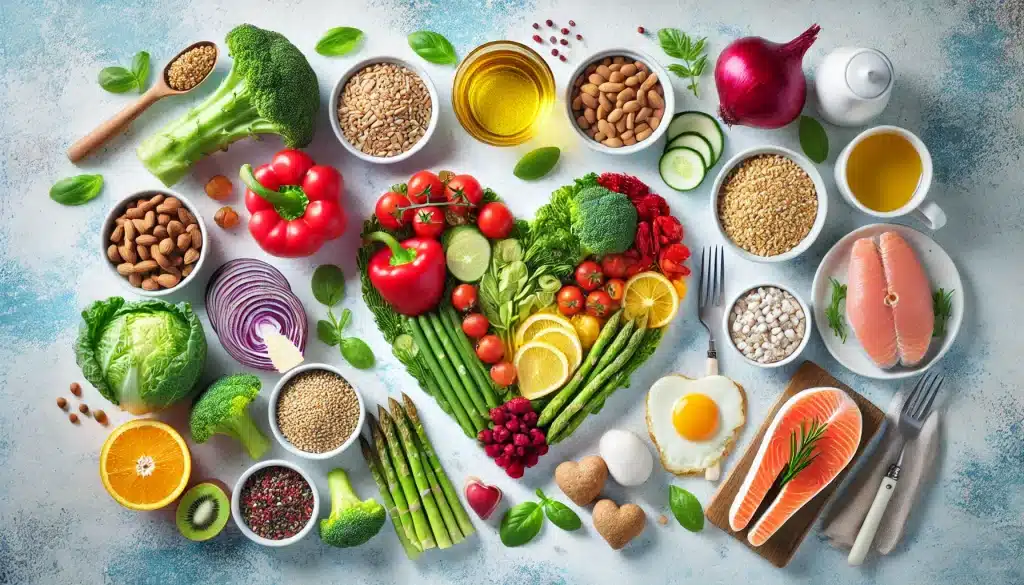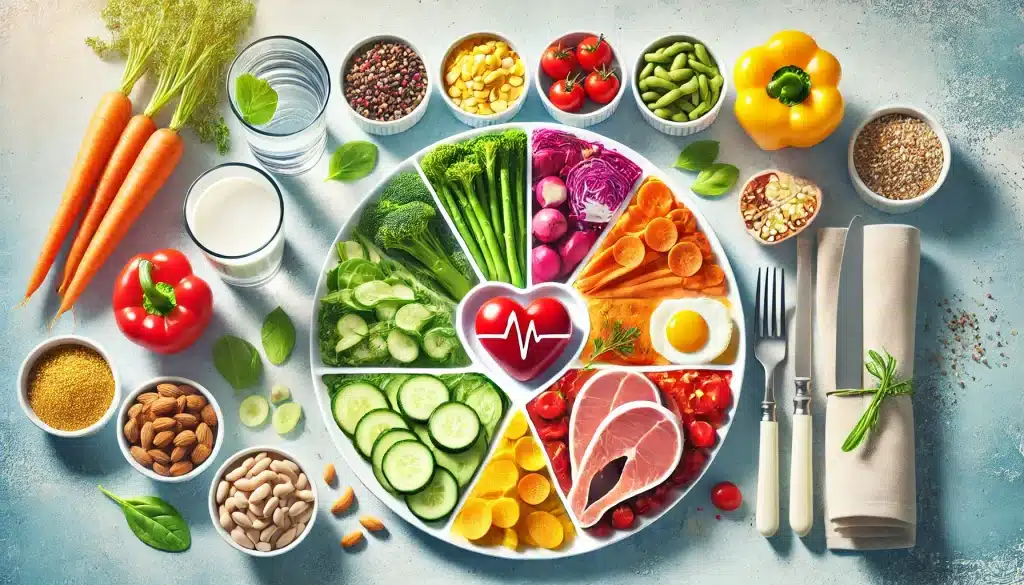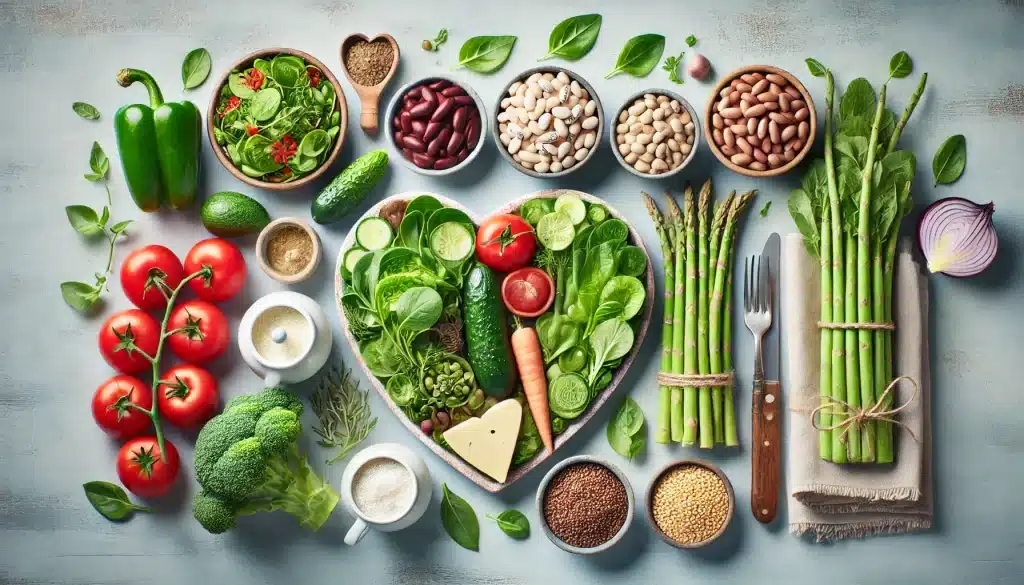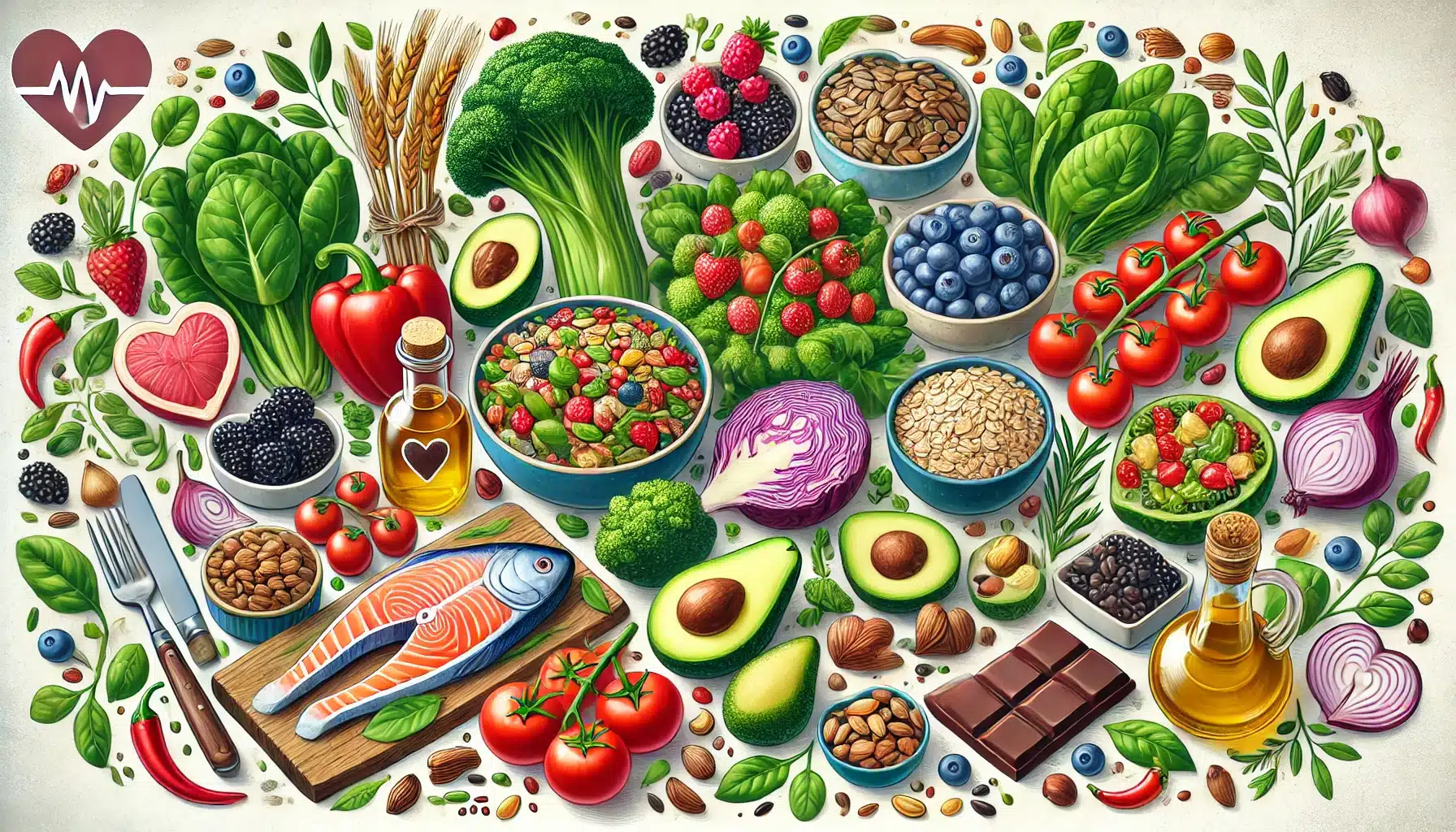What is a Heart-Healthy Meal?
Planning a heart-healthy meal is essential for maintaining cardiovascular health and supporting overall wellness. A heart-healthy meal emphasizes nutrient-dense foods, which provide essential vitamins, minerals, and antioxidants that help protect the heart from damage and reduce the risk of heart disease. Understanding what constitutes a heart-healthy meal can guide you in making the right food choices daily.

A balanced heart-healthy meal includes a variety of whole foods—such as fruits, vegetables, lean proteins, whole grains, and healthy fats—that work together to support heart function and improve blood circulation. Unlike restrictive diets, heart-healthy eating encourages flexibility and enjoyment while focusing on foods that enhance health and prevent cardiovascular issues.
- Fruits and Vegetables: Packed with vitamins, minerals, and antioxidants that are beneficial for heart health.
- Whole Grains: Rich in fiber, which helps reduce cholesterol and manage blood sugar levels.
- Healthy Fats: Sources like olive oil, avocado, and nuts provide beneficial monounsaturated and polyunsaturated fats.
- Lean Proteins: Chicken, fish, and legumes offer protein without the saturated fats found in red meats.
Incorporating a wide range of these foods into each meal ensures you’re meeting the daily nutritional needs for heart health while also creating enjoyable and flavorful dishes. Furthermore, heart-healthy meal planning reduces dependence on processed foods, which are often high in sodium, unhealthy fats, and added sugars—substances that can lead to cardiovascular complications over time.
Key Nutrients for Heart Health
Building a heart-healthy meal plan requires understanding the specific nutrients that actively support cardiovascular health. Certain nutrients play vital roles in maintaining optimal blood pressure, reducing cholesterol levels, and strengthening heart muscle function. Incorporating these nutrients into your diet can significantly impact heart health and protect against conditions like coronary artery disease, high blood pressure, and cholesterol-related issues.

Omega-3 Fatty Acids
Omega-3 fatty acids are essential for reducing inflammation in the body, particularly within blood vessels, which can lower the risk of heart disease. These healthy fats also help manage triglyceride levels, reduce blood pressure, and prevent arterial plaque buildup.
- Salmon: A rich source of omega-3s, offering high-quality protein and essential nutrients.
- Walnuts: Plant-based omega-3s make walnuts a great addition to heart-healthy meals.
- Flaxseeds: Ground flaxseeds can be added to smoothies or oatmeal for an omega-3 boost.
Fiber-Rich Foods
Fiber is crucial for lowering cholesterol and stabilizing blood sugar levels, both of which contribute to cardiovascular health. Dietary fiber helps reduce bad cholesterol (LDL) and promotes a healthier gut, further supporting the absorption of heart-friendly nutrients.
- Oats: A heart-healthy meal staple, oats are high in soluble fiber that helps lower LDL cholesterol.
- Beans: Rich in fiber and protein, beans are a versatile ingredient for soups, salads, and stews.
- Fruits and Vegetables: Many fruits and vegetables, including apples and carrots, are high in fiber and beneficial for heart health.
Antioxidant-Rich Ingredients
Antioxidants are powerful compounds that neutralize free radicals, reducing oxidative stress and inflammation in the body, which are linked to heart disease. Adding antioxidants to your meals can help protect heart cells and improve overall cardiovascular function.
- Berries: Blueberries, strawberries, and blackberries are high in antioxidants and great for heart health.
- Dark Chocolate: Rich in flavonoids, dark chocolate (in moderation) can be a heart-healthy treat.
- Green Leafy Vegetables: Spinach, kale, and other greens are high in vitamins and antioxidants that benefit the heart.
Including these nutrients in your daily diet ensures a well-rounded approach to heart-healthy meal planning. By balancing these nutrient-dense foods, you not only meet daily nutritional needs but also actively work to protect and enhance heart function.
Sample Heart-Healthy Recipes
Incorporating delicious and heart-healthy meal options into your daily routine doesn’t have to be challenging. With the right ingredients and cooking methods, you can enjoy flavorful dishes that support cardiovascular health. Here are a few sample recipes designed to be nutrient-dense, low in unhealthy fats, and easy to prepare at home.

Breakfast: Oatmeal with Fresh Berries
A hearty bowl of oatmeal is a perfect way to start your day, as it’s rich in fiber that helps lower cholesterol. Adding berries provides antioxidants that are beneficial for heart health.
- Ingredients: 1/2 cup rolled oats, 1 cup water or milk, 1/2 cup mixed berries (blueberries, strawberries), 1 tablespoon flaxseeds, honey (optional)
- Instructions: Cook oats with water or milk over medium heat until soft. Top with berries, flaxseeds, and a drizzle of honey if desired.
- Health Tip: Use unsweetened almond milk or low-fat milk to reduce saturated fat intake.
Lunch: Quinoa Salad with Mixed Vegetables
This quinoa salad is high in protein and fiber, making it a satisfying and heart-healthy meal. Quinoa is also rich in antioxidants, while fresh vegetables add essential vitamins and minerals.
- Ingredients: 1 cup cooked quinoa, 1/2 cup cherry tomatoes (halved), 1/2 cucumber (diced), 1/4 cup chopped bell peppers, 1 tablespoon olive oil, 1 tablespoon lemon juice, fresh herbs (like parsley or basil)
- Instructions: In a large bowl, combine cooked quinoa and chopped vegetables. Drizzle with olive oil and lemon juice, then mix in herbs. Season with salt and pepper to taste.
- Health Tip: Olive oil provides monounsaturated fats, which are excellent for heart health.
Dinner: Grilled Salmon with Steamed Greens
Salmon is an excellent source of omega-3 fatty acids that benefit heart health by reducing inflammation. Pairing it with steamed greens adds fiber, vitamins, and antioxidants for a balanced meal.
- Ingredients: 1 salmon fillet, 1 teaspoon olive oil, salt and pepper, 1 cup steamed broccoli or spinach
- Instructions: Brush the salmon fillet with olive oil and season with salt and pepper. Grill on medium heat for 4-5 minutes on each side until cooked through. Serve with steamed greens on the side.
- Health Tip: Avoid adding extra salt to keep sodium intake low.
These recipes are designed to fit seamlessly into a heart-healthy meal plan while offering variety and flavor. Whether you’re preparing breakfast, lunch, or dinner, choosing these nutrient-packed meals can help you maintain cardiovascular health while enjoying wholesome and delicious food.
Heart-Healthy Meal Planning for Special Diets
For individuals following specific dietary preferences or restrictions, adapting to a heart-healthy meal plan can be straightforward with the right modifications. Whether you follow a low-sodium diet, vegetarian or vegan lifestyle, or have other dietary needs, there are heart-friendly choices tailored to your preferences.

Low-Sodium Options
Limiting sodium intake is crucial for managing blood pressure and supporting heart health. Many processed foods contain hidden sodium, which can contribute to hypertension. By preparing meals at home and using fresh ingredients, you can better control sodium levels.
- Use Herbs and Spices: Replace salt with herbs like basil, rosemary, or thyme for flavor enhancement without added sodium.
- Choose Fresh Meats: Fresh poultry and meats contain less sodium than processed or deli meats.
- Read Labels: Opt for low-sodium versions of products when available, especially for items like canned beans or broths.
Vegetarian and Vegan Heart-Healthy Meals
Plant-based diets are naturally conducive to heart-healthy meal planning, as they emphasize fruits, vegetables, legumes, and whole grains, all of which are beneficial for cardiovascular health. When following a vegetarian or vegan diet, it’s essential to ensure adequate intake of nutrients like protein, iron, and vitamin B12.
- Beans and Lentils: These are excellent sources of protein and fiber that support heart health.
- Whole Grains: Foods like quinoa, brown rice, and whole-grain pasta provide complex carbohydrates and fiber.
- Healthy Fats: Avocados, nuts, and seeds offer plant-based fats that benefit the heart.
Whether you’re managing sodium intake or following a plant-based lifestyle, adjusting your diet to meet heart-healthy standards can be done by focusing on whole, nutrient-dense foods. These choices not only support cardiovascular health but also cater to individual dietary needs.
Frequently Asked Questions
What foods should I avoid for a heart-healthy diet?
For a heart-healthy diet, it’s best to limit foods high in saturated fats, trans fats, added sugars, and sodium. This includes items like fast food, processed snacks, sugary beverages, and red meats. Choosing whole foods like fruits, vegetables, and whole grains can help support heart health.
How much fiber do I need daily for heart health?
Aim for 25-30 grams of fiber per day as part of your heart-healthy meal plan. Fiber-rich foods such as oats, beans, fruits, and vegetables help reduce cholesterol levels, stabilize blood sugar, and promote healthy digestion, all of which benefit the heart.
Can a vegetarian or vegan diet support heart health?
Yes, a vegetarian or vegan diet can be excellent for heart health when properly balanced. Plant-based diets focus on foods rich in fiber, antioxidants, and healthy fats, which can help reduce the risk of heart disease. Be sure to include a variety of whole grains, legumes, vegetables, and healthy fats in your meals.
How often should I eat fish for omega-3 benefits?
To gain the heart-healthy benefits of omega-3 fatty acids, it’s recommended to eat fish, especially fatty fish like salmon or mackerel, at least twice a week. Omega-3s help reduce inflammation and support overall cardiovascular health.
What are some quick heart-healthy snacks?
Some simple and heart-healthy snack options include a handful of unsalted nuts, fresh fruit like apples or berries, a small serving of hummus with carrot sticks, or a slice of whole-grain toast with avocado. These snacks provide nutrients without excess salt or sugar, making them suitable for heart health.
Essential Tips for Planning Heart-Healthy Meals
Creating a heart-healthy meal plan goes beyond choosing the right ingredients. The way we prepare, portion, and balance our meals can significantly influence our heart health. By following these essential tips, you can enjoy flavorful, satisfying meals that support cardiovascular well-being without compromising on taste or nutrition.
Portion Control
Portion control is a key factor in maintaining a healthy weight, which in turn reduces strain on the heart. Eating balanced portions helps regulate calorie intake, supporting both weight management and optimal blood sugar levels. Try to fill half your plate with vegetables, a quarter with lean protein, and the remaining quarter with whole grains for a balanced meal.

- Visual Guides: Use visual cues such as a handful of nuts or a deck of cards for meat portions to maintain control.
- Smaller Plates: Using smaller plates can help reduce portion sizes without feeling deprived.
- Mindful Eating: Take time to eat slowly and savor each bite, which can help prevent overeating.
Avoiding Processed Foods
Processed foods are often high in sodium, added sugars, and unhealthy fats—all factors that can contribute to heart disease. Whenever possible, choose whole foods over packaged and processed items. Preparing meals from scratch allows you to control the ingredients and reduce hidden additives that may harm heart health.
- Fresh Ingredients: Opt for fresh fruits, vegetables, and lean proteins rather than canned or processed versions.
- Check Labels: When buying packaged items, look for labels with minimal ingredients and low sodium and sugar content.
- Healthy Snacks: Prepare homemade snacks, like mixed nuts or fresh-cut veggies, instead of reaching for processed snacks.
Choosing Healthy Cooking Methods
The way food is prepared can affect its nutritional value and impact on heart health. Frying foods or adding excessive oil and salt can turn healthy ingredients into less beneficial meals. Opt for cooking methods that preserve nutrients while minimizing unhealthy fats.
- Grilling: Grilling meats and vegetables enhances flavor while requiring minimal added fat.
- Steaming: Steaming vegetables retains their nutrients, making them a healthy choice for side dishes.
- Baking: Baking is a low-fat cooking option that works well for proteins and vegetables.
By implementing these tips, you can create meals that align with heart-healthy meal planning principles, helping you enjoy nourishing food that also protects your heart. These small adjustments in your cooking routine can make a big difference in supporting a healthy lifestyle.



